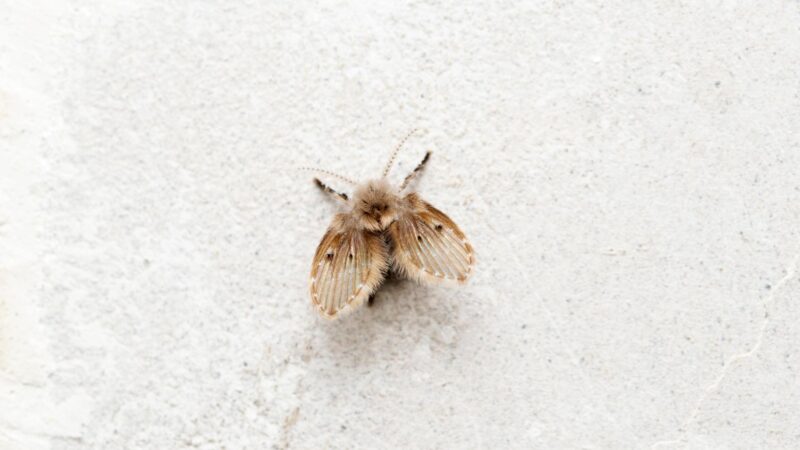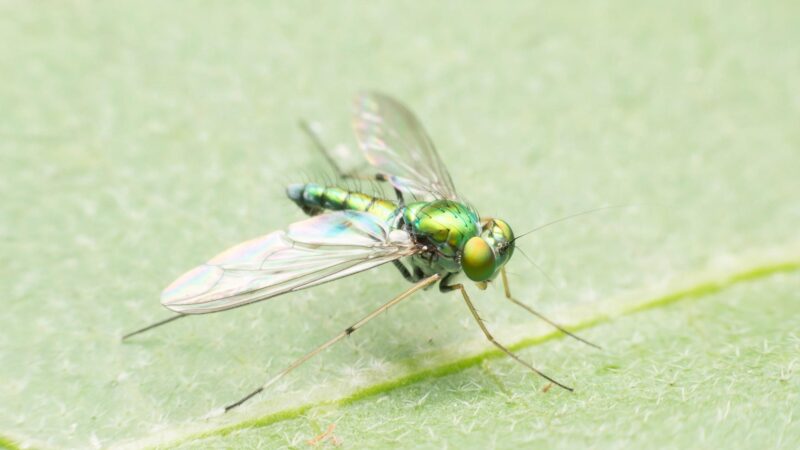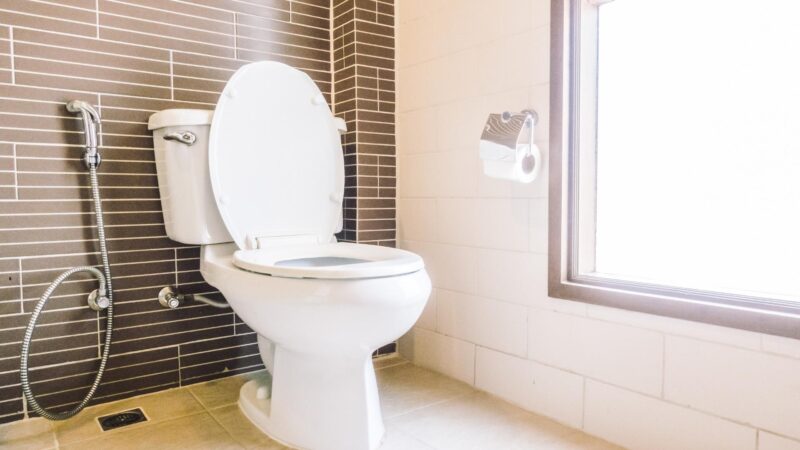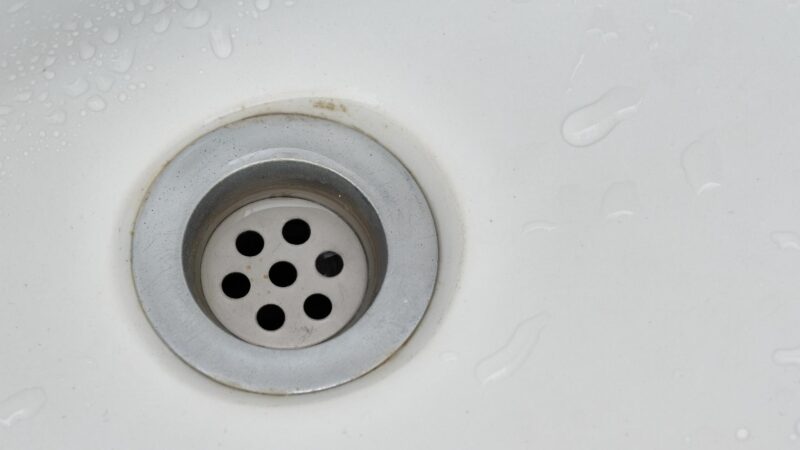If you spot some flies that look like moths hovering near your drain, they are likely to be drain flies. These fly species cannot fly that far, but they congregate in stagnant water.
Although drain flies seem to be easy to eliminate, they are very challenging to deal with. A drain fly infestation is a common problem in homes.
How to get rid of drain flies? To get rid of drain flies, focus on their food sources and natural habitat – toilets and drains. For adult drain flies, you may use a fly swatter or fly traps. But for the larvae, you should carefully inspect your drains and clean them thoroughly. Check also if you have some plumbing problems.
Drain flies are very stubborn pests and breed very fast. But before taking any action, knowing first how to identify them correctly is very important.
Once you understand their habits and behavior, it will help you a lot in getting rid of them. Below is a complete guide about drain flies and how to control them effectively.
Table of Contents
What Are Drain Flies?

Scientifically known as Psychodidae, drain flies are in the order of Diptera and are originally from North America.
There are over 2,500 drain fly species around the world, and the most common species found in the US is the Psychoda alternata. Drain flies are also called moth flies because of their moth-like appearance.
Like houseflies, drain flies also undergo complete metamorphosis or have four life stages – egg, larva, pupa, and adult. Eggs hatch within 48 hours and larvae pass through three instars (stage) before they become pupae.
Depending on the temperature, drain flies can complete their life cycle from 8 to 24 days.
How to Identify Drain Flies?
Drain fly eggs are transparent or light brown, less than 1 mm in length, and are laid in masses between 10 and 200. Their legless larvae have creamy white to brown bodies with 11 segments and look like mosquito larvae.
They have a distinct head and a siphon on one end and are about 1/4 inches (6.35 mm.) long.
Adult drain flies have gray to dark bodies, long antennae, and a pair of large wings that are heavily covered with hairs, which make them look like moths when they are at rest. Female drain flies are 4-4.5 mm long, while males are only about 2.5 to 3 mm long. Both sexes are weak fliers and fly at very short distances only.
What Do Drain Flies Eat?
As the name implies, drain fly larvae feed on algae, bacteria, fungi, and other microorganisms and decaying organic matter found in moist areas such as drains, standing water, sewage filter beds, faulty septic lines, condensate pipes, and seldom-used toilets. If there is a food shortage, they may also eat each other.
Adult drain flies mainly feed on flower nectar or any kind of liquid carbohydrates, including polluted water. These adults have an average lifespan of 1-2 weeks, but they can only live for 3 days without food.
On the other hand, drain fly larvae need moisture to survive. Without water, they may survive only for about a week.
Drain Flies vs. Fruit Flies

Like drain flies, fruit flies are also weak fliers and breed in drains and around the bathroom. They can also be found in garbage cans, empty bottles, and other damp items.
But as their name suggests, they feed on fermenting overripe fruits and vegetables. This includes bananas, grapes, onions, peaches, and potatoes.
Scientifically known as Drosophila melanogaster, adult fruit flies are about 1/8 inches (3.17 mm) long, with dark to brown, cylindrical bodies and translucent wings.
Physically, the main difference between drain flies and fruit flies is that the latter usually have bright red eyes. Dark-eyed fruit flies have black eyes, though.
Are Drain Flies Harmful?
Drain flies are not harmful since they don’t bite or sting humans and pets. They also don’t carry diseases nor contaminate food.
However, a large number of disintegrated bodies of dead drain flies can cause allergic reactions in people with weak immune systems. Drain flies also don’t damage plants and structures.
What Causes Drain Flies?
Drain flies prefer being outdoors to indoors. But still, adults enter houses to find a source of moisture where they can breed.
Although they are mostly found in contaminated water, these nuisance pests also live in clean areas with standing water. This is why drain flies love homes with nobody inside for quite some time.
Can Drain Flies Come From the Toilet?

Drain flies can come from the toilet but are quite rare. This scenario may only happen if you have a clogged toilet, there is a ring of slime under the lips of your toilet bowl, or your toilet is seldom being used.
This means that your toilet is full of bacteria or standing water that has not been moved for a long time.
How Can You Tell if You Have Drain Flies?
Adult drain flies are generally nocturnal creatures, which means they usually do their activities at night and rest during the day.
However, it does not necessarily mean you cannot find them during the daytime. Now that you know what drain flies look like, here are some useful tips to help you know that they are inside your house:
1. Check Your Drains
Bathroom and kitchen drains are favorite breeding sites of drain flies. Before you sleep, place a clear packing tape across them but don’t cover the opening completely.
Otherwise, adult drain flies will not emerge since there will be no airflow. Check the tape in the morning and see if some drain flies got stuck on it.
2. Check Your Bathroom
During the daytime, adult drain flies are resting or hanging in shaded, wet areas, including bathroom walls, around your shower or bathtub, and near plumbing fixtures.
At night, you may find them flying low or hopping in your bathroom drains. Meanwhile, drain fly larvae tend to hide in moldy and secured areas.
3. Check Your Toilet Flange
As mentioned earlier, drain flies may also breed in toilets. Check your toilet flange – the circular pipe fitting that connects your toilet to the drainage system.
If there is always water at the base of your toilet, the toilet flange may be broken. To check, move the bolts and lift your toilet. There, you may find drain fly larvae.
4. Check Your Toilet Tank
If your flush is not working, drain flies may breed inside your toilet tank. But even if your flush is working well, this scenario is still very likely to happen if the tank cover is missing or broken and if the toilet is seldom used.
Again, drain flies are very attracted to standing water, especially if it contains decaying organic material.
5. Check Under the Toilet Rim
If your toilet is working properly, but you still see some adult drain flies, check under the toilet rim. If you find some brown or green stains, these are lime buildup that drain fly larvae feed on.
This dark ring under the toilet rim contains bacteria called Serratia Marcescens, which can cause some infectious diseases.
6. Check Plumbing Pipes
Aside from drains and toilets, drain flies also love to lay eggs on plumbing pipes. As expected, these pipes have moisture that attracts these fast-breeding pests.
If your pipes are not receiving regular water flow, drain flies will surely make them their home. They will also present if you have plumbing problems.
How Do You Stop Bugs From Coming up the Drain?

Whether it is in the kitchen or bathroom, bugs that come up the drain can be very annoying. Aside from drain flies, the other bugs and insects that could come up to your drain include fruit flies, phorid flies, and fungus gnats.
Here are some quick tips on how to stop these nuisance pests from coming up your drains:
- Check the drain for possible clogging.
- Trap the bugs by putting tape on the drain.
- Plug the drain if you are not using it.
- Pour a powerful drain cleaner down the drain.
- Clean the drain thoroughly with a brush or “snake.”
How Long Does It Take To Get Rid of Drain Flies?
It depends on how many drain flies are present, as well as the location of their breeding sites. For mild cases, it may take a week to get rid of drain flies. For severe infestations, it may take 20-30 days.
Yet, the key to faster and more effective results comes with persistent treatment, careful attention, and extreme patience.
Will Drano Get Rid of Drain Flies?
Drano drain cleaners such as Drano Max Gel Clog Remover can get rid of drain flies. Being one of the most trusted names in drain cleaning, Drano drain cleaners are made up of concentrated sodium hydroxide (lye), which is powerful enough to unclog sinks and drains but doesn’t damage the metal or PVC pipes.
To work effectively, Drano recommends allowing their drain cleaners to sit for 15-20 minutes before pouring hot water, depending on the severity of the problem.
In some severe cases, you may need to apply the product repeatedly. The company also reminds its customers not to use their clog removers in toilets.
How Does Vinegar Get Rid of Drain Flies?
White vinegar contains acetic acid that kills drain flies. However, pouring white vinegar down the drain is not so effective since it can kill larvae that are only on the surface of the organic material.
This is because white vinegar cannot penetrate thick, accumulated material, thus leaving some drain fly larvae alive.
You can also mix white vinegar with soap and sugar to make an effective drain fly trap. The sweet, sugary solution will then attract adult drain flies, which will eventually get drowned.
Apple cider vinegar is also a great alternative. But then, these traps only work against exposed drain flies, not those inside the drains.
Do Drain Flies Eventually Go Away?
Drain flies will not go away unless you take action. They will leave only if their breeding sites and larval food sources are gone. In fact, these stubborn pests will keep on coming back no matter how many times you clean your house.
As long as drain flies can find a way to enter your house, they will always try to come in.
What Smells Do Drain Flies Hate?
Like houseflies, drain flies also hate the smell of bleach, vinegar, and some essential oils. This includes essential oils from cinnamon, eucalyptus, peppermint sunflower, tea tree, lavender, and vetiver.
Note that essential oil sprays repel adult drain flies but will not kill them. They also don’t work when sprayed in drains.
What Spray Kills Drain Flies?
Soapy water spray kills drain flies on contact. To make a soap solution, mix equal parts of water and dishwashing liquid soap. For better results, use Southern Ag Natural Pyrethrin Concentrate.
This organic insecticide not only kills adult drain flies on bathroom walls; it can also be used on vegetables and ornamental plants.
How Do I Get Rid of Drain Flies in My Bathroom?
Since adult drain flies are weak fliers, you can easily see them on the walls of your bathroom or near the drain. On the other hand, drain fly larvae like to stay on wet organic matter, especially in drains, pipes, and toilets.
Aside from the ones mentioned above, here are other effective ways to get rid of drain flies:
1. Use a Fly Swatter
If there are only a few adult drain flies in your bathroom, kill them by using an eco-friendly and durable fly swatter such as Kensizer Heavy Duty Plastic Fly Swatters.
While swatting these pesky pests, you should also monitor where they are coming from. Otherwise, another batch of drain flies will soon appear.
2. Place Drain Fly Traps
To use white vinegar with soap and sugar as an effective drain fly trap, place the sweet solution in a bowl and leave it overnight near the bathroom drain.
If you have apple cider vinegar, pour it into a glass jar and cover it with plastic. Make some small holes on top so drain flies can come in but can no longer escape.
3. Clean Your Drains
Avoid pouring bleach into your drain to kill drain flies. Aside from being corrosive and can damage your pipes, this technique is not that effective.
Like vinegar or boiling water, a bleach solution is only a short-term solution. Instead, use a flexible nylon drain brush, along with hot water with soap or Drano drain cleaners.
4. Use a Drain Snake
If a clogged drain cannot be solved using drain cleaners, use a drain snake such as Drainsoon 30-inch Snake Drain Clog Remover.
Also called a plumber’s snake, a drain snake is a long, slender drain cleaning tool that is fed down into a drain to remove a blockage. This is also applicable to kitchen sinks.
5. Fix and Clean Your Toilet
As previously mentioned, drain flies can also come from the toilet if it is not functioning properly. If the flush is not working, repair or replace the flush valve as soon as possible.
If water is clogged at the base of the toilet, replace the toilet flange. Clean the underside of the toilet rim with a brush and bleach solution.
How to Prevent Drain Flies?
So far, there are two ways to prevent drain flies from entering your house – block all their possible points of entry and remove all the attractants.
Nonetheless, that seems to be impossible since drain flies are very small and we use water every day. To make it possible, combine all the useful tips in the list below:
- Use the toilet and bathroom regularly. Always flush the toilet and cover the toilet seat after use.
- Clean drains at least once a week using baking soda and vinegar, followed by hot water.
- If standing water cannot be avoided, always cover it properly.
- Adult drain flies are very attracted to UV light and lights at night. Instead of using bulbs for your outdoor lighting, use sodium vapor lamps.
- Empty the condensation drip pans under refrigerators from time to time.
- Replace damaged screens on windows and doors, and place mesh wires on air vents.
- For rarely used drains and pipes, run water through them at least once a week. Leaky pipes should also be fixed or replaced at once.
- If possible, place air curtains such as Awoco Super Power Indoor Air Curtain above the doors, especially in the kitchen.
- If no one will be left inside the house for a long time, close all the doors and windows properly. Also, cover the drains with a V-TOP Tub Stopper.
Summary
Although all strategies mentioned above are effective if they are properly executed, there is no guarantee that drain flies will no longer appear.
Controlling them needs continuous effort and a truckload of patience. But if these drain flies become very troublesome, ask for help from a professional pest exterminator.